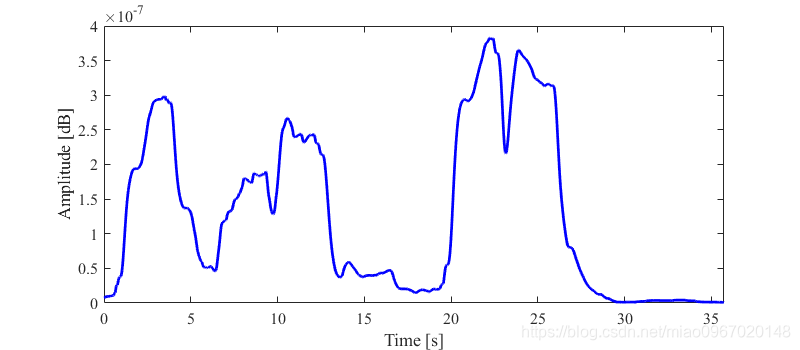1.瞬时能量
信号瞬时能量定义为:
对于信号,在此信号上应用第 个帧窗口:
是窗长
是帧移
MATLAB 代码:
function En = energy(x,wintype,winamp,winlen)
%ENERGY Short-time energy computation.
% y = ENERGY(X,WINTYPE,WINAMP,WINLEN) computes the short-time enery of
% the sequence X.
%
% WINTYPE defines the window type. RECTWIN, HAMMING, HANNING, and
% BLACKAMN are the possible choices. WINAMP sets the amplitude of the
% window and the length of the window is WINLEN.
error(nargchk(1,4,nargin,'struct'));
% generate the window
win = (winamp*(window(str2func(wintype),winlen))).';
% enery calculation
x2 = x.^2;
En = winconv(x2,wintype,win,winlen);结果:


2.过零率
信号中的高频段有高的过零率,低频段过零率较低。短时能量大的地方过零率小,短时能量小的地方过零率较大。
其中,
MATLAB源代码:
function zc = zerocross(x,wintype,winamp,winlen)
%ENERGY Short-time energy computation.
% y = ZEROCROSS(X,WINTYPE,WINAMP,WINLEN) computes the short-time enery of
% the sequence X.
%
% WINTYPE defines the window type. RECTWIN, HAMMING, HANNING, and
% BLACKAMN are the possible choices. WINAMP sets the amplitude of the
% window and the length of the window is WINLEN.
error(nargchk(1,4,nargin,'struct'));
% generate x[n] and x[n-1]
x1 = x;
x2 = [0, x(1:end-1)];
% generate the first difference
firstDiff = sgn(x1)-sgn(x2);
% magnitude only
absFirstDiff = abs(firstDiff);
% lowpass filtering with window
zc = winconv(absFirstDiff,wintype,winamp,winlen);
结果:

3.排列熵
PE分析一维时间序列,便于分析,考虑一个示例:
划分状态空间:将一维时间序列划分为重叠列向量的矩阵。 此分区使用两个超参数:
:嵌入时间延迟,它控制每个新列向量的元素之间的时间段数。默认值为
。
:嵌入尺寸,用于控制每个新列向量的长度。默认值为
。
用 和
,示例数据按以下方式划分:
每个列向量都有3个元素,因为嵌入维设置为3。此外,由于嵌入时间延迟设置为1,因此向量中每个元素之间只有一个时间段。为
维向量创建的列向量的数量为
。
示例数据的矩阵包含列向量 。
划分一维时间序列后,维向量映射到唯一的排列中,这些排列捕获数据的有序排列:
遵循上面的示例,总共有不同的可能排列(普通模式):
这些置换根据值在矢量中的顺序位置将值分配给每个分区矢量。 考虑示例的首3维向量
因为 ,此向量的置换是
。 因此,对于示例数据,置换矩阵为
如果输入向量包含两个或多个具有相同值的元素,则排名由它们在序列中的顺序确定。通过添加白噪声来打破平局,其中随机项的强度小于值之间的最小距离。
计算相对频率:可以通过计算在时间序列中找到置换的次数除以序列总数,来计算每个置换的相对频率。

计算PE:最后,先前的概率用于计算时间序列阶数的PE,由下式给出:
继续上例,第3阶的PE为
PE中的PE值也可以标准化为
MATLAB代码:
function outdata = PE( indata, delay, order, windowSize )
% @brief PE efficiently [1] computes values of permutation entropy [2] in
% maximally overlapping sliding windows
%
% INPUT
% - indata - considered time series
% - delay - delay between points in ordinal patterns (delay = 1 means successive points)
% - order - order of the ordinal patterns (order+1 - number of points in ordinal patterns)
% - windowSize - size of sliding window
% OUTPUT
% - outdata - values of normalised permutation entropy as defined in [2]
%
% REFERENCES
% [1] Unakafova, V.A., Keller, K., 2013. Efficiently measuring complexity
% on the basis of real-world data. Entropy, 15(10), 4392-4415.
% [2] Bandt C., Pompe B., 2002. Permutation entropy: a natural complexity
% measure for time series. Physical review letters, APS
%
load( ['table' num2str( order ) '.mat'] ); % the precomputed table
patternsTable = eval( ['table' num2str( order )] );
nPoints = numel( indata ); % length of the time series
opOrder1 = order + 1;
orderDelay = order*delay;
nPatterns = factorial( opOrder1 ); % amount of ordinal patterns
patternsDistribution = zeros( 1, nPatterns ); % distribution of ordinal patterns
outdata = zeros( 1, nPoints ); % values of permutation entropy
inversionNumbers = zeros( 1, order ); % inversion numbers of ordinal pattern (i1,i2,...,id)
prevOP = zeros( 1, delay ); % previous ordinal patterns for 1:opDelay
ordinalPatternsInWindow = zeros( 1, windowSize ); % ordinal patterns in the window
ancNum = nPatterns./factorial( 2:opOrder1 ); % ancillary numbers
peTable( 1:windowSize ) = -( 1:windowSize ).*log( 1:windowSize ); % table of precomputed values
peTable( 2:windowSize ) = ( peTable( 2:windowSize ) - peTable( 1:windowSize - 1 ) )./windowSize;
for iTau = 1:delay
cnt = iTau;
inversionNumbers( 1 ) = ( indata( orderDelay + iTau - delay ) >= indata( orderDelay + iTau ) );
for j = 2:order
inversionNumbers( j ) = sum( indata( ( order - j )*delay + iTau ) >= ...
indata( ( opOrder1 - j )*delay + iTau:delay:orderDelay + iTau ) );
end
ordinalPatternsInWindow( cnt ) = sum( inversionNumbers.*ancNum ); % first ordinal patterns
patternsDistribution( ordinalPatternsInWindow( cnt )+ 1 ) = ...
patternsDistribution( ordinalPatternsInWindow( cnt ) + 1 ) + 1;
for j = orderDelay + delay + iTau:delay:windowSize + orderDelay % loop for the first window
cnt = cnt + delay;
posL = 1; % the position of the next point
for i = j - orderDelay:delay:j - delay
if( indata( i ) >= indata( j ) )
posL = posL + 1;
end
end
ordinalPatternsInWindow( cnt ) = ...
patternsTable( ordinalPatternsInWindow( cnt - delay )*opOrder1 + posL );
patternsDistribution( ordinalPatternsInWindow( cnt ) + 1 ) = ...
patternsDistribution( ordinalPatternsInWindow( cnt ) + 1 ) + 1;
end
prevOP( iTau ) = ordinalPatternsInWindow( cnt );
end
ordDistNorm = patternsDistribution/windowSize;
tempSum = 0;
for iPattern = 1:nPatterns
if ( ordDistNorm( iPattern ) ~= 0 )
tempSum = tempSum - ordDistNorm( iPattern )*log( ordDistNorm( iPattern ) );
end
end
outdata( windowSize + delay*order ) = tempSum;
iTau = mod( windowSize, delay ) + 1; % current shift 1:delay
patternPosition = 1; % position of the current pattern in the window
for t = windowSize + delay*order + 1:nPoints % loop over all points
posL = 1; % the position of the next point
for j = t-orderDelay:delay:t-delay
if( indata( j ) >= indata( t ) )
posL = posL + 1;
end
end
nNew = patternsTable( prevOP( iTau )*opOrder1 + posL ); % incoming ordinal pattern
nOut = ordinalPatternsInWindow( patternPosition ); % outcoming ordinal pattern
prevOP( iTau ) = nNew;
ordinalPatternsInWindow( patternPosition ) = nNew;
nNew = nNew + 1;
nOut = nOut + 1;
if ( nNew ~= nOut ) % update the distribution of ordinal patterns
patternsDistribution( nNew ) = patternsDistribution( nNew ) + 1; % incoming ordinal pattern
patternsDistribution( nOut ) = patternsDistribution( nOut ) - 1; % outcoming ordinal pattern
outdata( t ) = outdata( t - 1 ) + ( peTable( patternsDistribution( nNew ) ) - ...
peTable( patternsDistribution( nOut ) + 1 ) );
else
outdata( t ) = outdata( t - 1 );
end
iTau = iTau + 1;
patternPosition = patternPosition + 1;
if ( iTau > delay )
iTau = 1;
end
if ( patternPosition > windowSize )
patternPosition = 1;
end
end
outdata = outdata( windowSize + delay*order:end )/log( factorial( order + 1 ) );
























 3108
3108











 被折叠的 条评论
为什么被折叠?
被折叠的 条评论
为什么被折叠?








